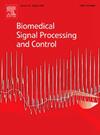基于视觉感知的多任务学习多尺度乳腺癌超声图像分割与分类
IF 4.9
2区 医学
Q1 ENGINEERING, BIOMEDICAL
引用次数: 0
摘要
乳腺肿瘤的分割与分类是乳腺超声计算机辅助诊断(CAD)系统的重要组成部分,有助于提高乳腺癌诊断的准确性。然而,由于肿瘤特征的复杂性,病变与周围组织强度的相似性,以及肿瘤形状和位置的变化,带来了挑战。虽然深度学习在CAD系统中得到了广泛的应用,但许多现有的方法忽略了分割和分类任务之间的关系,限制了它们的有效性。我们提出了一种基于感知的多尺度超声图像分割与分类多任务学习网络PMSMT-Net,它提高了超声图像的分割和分类性能。该分割网络集成了视觉感知模块(VPM)来模拟感兴趣区域的类人焦点,并结合多尺度扩展卷积(MSDC),准确捕获形态、位置和边缘特征。为了进一步提高分割精度,我们引入了可变残差卷积块注意模块(VR-CBAM)和基于感受野块的感知可分离卷积模块(RFB-PSC),增强了上下文特征融合,减少了空间信息丢失。VPM输出以及分割结果随后被用作分类网络的输入,在分类网络中,使用迁移学习和集成学习方法对乳腺肿瘤进行分类。与最先进的方法相比,PMSMT-Net在两个公共BUS数据集上的Dice系数平均提高3.7%,分类精度平均提高3.6%。这些结果表明,该模型可以显著推进基于bus的肿瘤分析,对提高诊断精度和患者预后具有重要意义。本文章由计算机程序翻译,如有差异,请以英文原文为准。
Multi-task learning for multi-scale breast cancer ultrasound image segmentation and classification based on visual perception
Breast tumor segmentation and classification are essential components of breast ultrasound (BUS) computer-aided diagnosis (CAD) systems, which help improve the accuracy of breast cancer diagnoses. However, challenges arise due to the complexity of tumor features, the intensity similarities between lesions and surrounding tissues, as well as variations in tumor shape and location. While deep learning has been widely applied in CAD systems, many existing approaches overlook the relationship between segmentation and classification tasks, limiting their effectiveness. We propose PMSMT-Net, a Perception-based Multi-scale Ultrasound Image Segmentation and Classification Multi-task Learning Network, which enhances both segmentation and classification performance in BUS images. The segmentation network integrates a Visual Perception Module (VPM) to simulate human-like focus on regions of interest and, combined with Multi-scale Dilated Convolution (MSDC), accurately captures morphological, locational, and edge features. To further improve segmentation accuracy, we introduce the Variable Residual Convolutional Block Attention Module (VR-CBAM) and the Receptive Field Block-based Perceptually Separable Convolution Module (RFB-PSC), which enhance context feature fusion and reduce spatial information loss. The VPM output, along with the segmentation results, is then used as input to the classification network, where a transfer learning and ensemble learning approach classifies breast tumors. Compared to state-of-the-art methods, PMSMT-Net achieves an average improvement of 3.7% in Dice coefficient and 3.6% in classification accuracy on two public BUS datasets. These results demonstrate the proposed model can significantly advance BUS-based tumor analysis and is of great significance for improving diagnostic precision and patient outcomes.
求助全文
通过发布文献求助,成功后即可免费获取论文全文。
去求助
来源期刊

Biomedical Signal Processing and Control
工程技术-工程:生物医学
CiteScore
9.80
自引率
13.70%
发文量
822
审稿时长
4 months
期刊介绍:
Biomedical Signal Processing and Control aims to provide a cross-disciplinary international forum for the interchange of information on research in the measurement and analysis of signals and images in clinical medicine and the biological sciences. Emphasis is placed on contributions dealing with the practical, applications-led research on the use of methods and devices in clinical diagnosis, patient monitoring and management.
Biomedical Signal Processing and Control reflects the main areas in which these methods are being used and developed at the interface of both engineering and clinical science. The scope of the journal is defined to include relevant review papers, technical notes, short communications and letters. Tutorial papers and special issues will also be published.
 求助内容:
求助内容: 应助结果提醒方式:
应助结果提醒方式:


